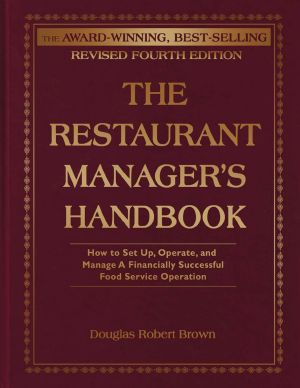The Restaurant Manager's Handbook

- Authors
- Brown, Douglas Robert
- Publisher
- Atlantic Publishing Group Inc.
- Tags
- employees , manage , interview , food service , business , principles , train , reference , franchising , hospitality , suppliers , restaurant , irs regulations , equipment , hire , management , run , resources , safe
- Date
- 2002-01-01T00:00:00+00:00
- Size
- 17.84 MB
- Lang
- en
The multiple award-winning Restaurant Manager s Handbook is the best-selling book on running a successful food service. Now in the fourth completely revised edition, nine new chapters detail restaurant layout, new equipment, principles for creating a safer work environment, and new effective techniques to interview, hire, train, and manage employees. We provide a new chapter on tips and IRS regulations as well as guidance for improved management, new methods to increase your bottom line by expanding the restaurant to include on- and off-premise catering operations. We ve added new chapters offering food nutrition guidelines and proper employee training. The Fourth Edition of the Restaurant Manager s Handbook is an invaluable asset to any existing restaurant owner or manager as well as anyone considering a career in restaurant management or ownership. All existing chapters have new and updated information. This includes extensive material on how to prepare a restaurant for a potential sale. There is even an expanded section on franchising. You will find many additional tips to help restaurant owners and managers learn to handle labor and operational expenses, rework menus, earn more from better bar management, and introduce up-scale wines and specialties for profit. You will discover an expanded section on restaurant marketing and promotion plus revised accounting and budgeting tips. This new edition includes photos and information from leading food service manufacturers to enhance the text. This new, comprehensive 800-page book will show you step-by-step how to set up, operate, and manage a financially successful food service operation. The author has taken the risk out of running a restaurant business. Operators in the non-commercial segment as well as caterers and really anyone in the food service industry will rely on this book in everyday operations. Its 28 chapters cover the entire process of a restaurant start-up and ongoing management in an easy-to-understand way, pointing out methods to increase your chances of success and showing how to avoid the many mistakes arising from being uninformed and inexperienced that can doom a restaurateur's start-up. While providing detailed instruction and examples, the author leads you through finding a location that will bring success, learning how to draw up a winning business plan, how to buy and sell a restaurant, how to franchise, and how to set up basic cost-control systems. You will have at your fingertips profitable menu planning, sample restaurant floor plans and diagrams, successful kitchen management, equipment layout and planning, food safety, Hazardous and Critical Control Point (HACCP) information, and successful beverage management. Learn how to set up computer systems to save time and money and get brand new IRS tip-reporting requirements, accounting and bookkeeping procedures, auditing, successful budgeting and profit planning development. You will be able to generate high profile public relations and publicity, initiate low cost internal marketing ideas, and low- and no-cost ways to satisfy customers and build sales. You will learn how to keep bringing customers back, how to hire and keep a qualified professional staff, manage and train employees as well as accessing thousands of great tips and useful guidelines. This Restaurant Manager s Handbook covers everything that many consultants charge thousands of dollars to provide. The extensive resource guide details more than 7,000 suppliers to the industry virtually a separate book on its own. This reference book is essential for professionals in the hospitality field as well as newcomers who may be looking for answers to cost-containment and training issues.